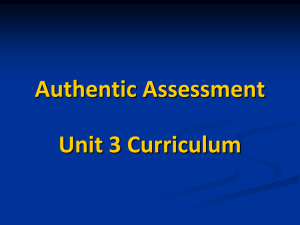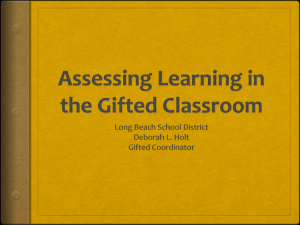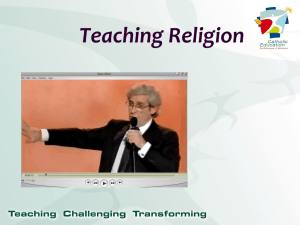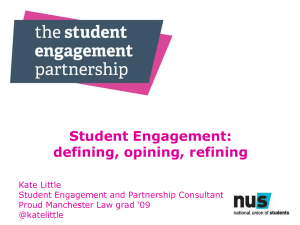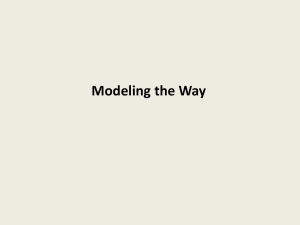Texts, students and meaningful language practice
advertisement
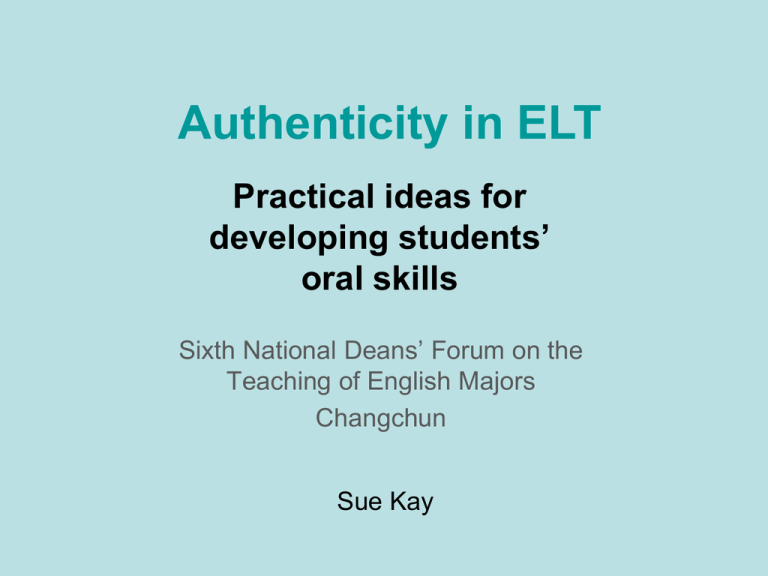
Authenticity in ELT Practical ideas for developing students’ oral skills Sixth National Deans’ Forum on the Teaching of English Majors Changchun Sue Kay Authenticity A classroom text is authentic if it was originally written for a non-classroom audience. The notion of authenticity was originally introduced to distinguish between artificially simplified texts and unmodified ‘real’ texts. However there has been a backlash against the authenticity movement. The fact that classroom interactions are artificial (by the standards of non-classroom contexts) may actually be based on good sense. Learning a language requires that the content of instruction should be modified in ways that make it more accessible to learners. Scott Thornbury, An A-Z of ELT This talk Authentic material Choosing engaging content. Adapting texts so that they are accessible and useful as language input. Authentic interaction Creating conditions for students to use natural language in meaningful contexts. Authentic tasks Speaking activities that encourage students to talk about things they are likely to talk about outside the classroom. Authentic material Choosing engaging content. Adapting texts so that they are accessible and useful as language input. Engaging content “The truth of the matter is that about ___% of teaching is making the students feel interested in the material. Then the other ___% has to do with your methods.” Noam Chomsky Engaging content “The truth of the matter is that about 99% of teaching is making the students feel interested in the material. Then the other 1% has to do with your methods.” Noam Chomsky Engaging content New Inside Out Beginner Engaging content MAN :Time 6 minutes. Spends $35 WOMAN :Time 3 hours 26 minutes. Spends $890 New Inside Out Elementary Engaging content New Inside Out Elementary Engaging content New Inside Out Intermediate Engaging content New Inside Out Upper Intermediate Why authentic texts? Interest-raising. Motivating. Show language as it is really used in all its richness and complexity. Prepare students for the real world. Increases the chances of eliciting genuine responses. Choosing an authentic text 1 Is it interesting? If the interest of students is not engaged, the learning process is unlikely to get off the ground at all. Professor H.G. Widdowson 2003 Choosing an authentic text 2 Is there anything in this text that my students can relate to their own lives? We believe our job as teachers is to concentrate on how our students speak and write. This can be achieved when what they speak and write about is part of their life experience. It is much more difficult to achieve when the topic of the lesson is alien to students – something they have never considered before. New Inside Out Teacher’s book Choosing an authentic text 3 Can they learn something about the language? BUT Texts written merely to include examples of a given grammatical structure are often boring to read and unconvincing as discourse. SO A solution is to base reading texts on authentic modern sources and where necessary, edit and grade them to make them challenging without being impossible. Adapting an authentic text A principled approach to choosing and adapting authentic texts. We might say that in the context of the classroom, appropriate language is language that learners can appropriate. Professor H.G. Widdowson, 2003 Choosing an authentic text The Guggenheim museum, Bilbao, Spain Adapting an authentic text ORIGINAL TEXT If, as a native of Bilbao, you had happened to see a balding, middle-aged American in trainers and sweatpants jogging past the Jesuit university along the banks of the Nervion early one morning in April 1991, you might, quite reasonably, have shrugged your Basque shoulders and said to yourself, “Crazy Yankee”. And you would have been half right. We will never quantify exactly what jogging has done for western civilisation, but one thing is certain. If Thomas Krens, the newly appointed director of the Solomon R Guggenheim Foundation, had not gone jogging that April morning six years ago, his brainchild the Bilbao Guggenheim – a titanium-clad, post-modern, space-age museum that has the world’s architectural community in a tizzy of excitement – would almost certainly never have been built. In years to come this will no doubt seem a quite extraordinary thought. From the moment you leave Bilbao airport and wind past the desolation of contemporary highway construction, through the green hills of northern Spain towards the ochre-brown 19th-century jumble of Bilbao, the barely completed museum can be glimpsed in the distance, a shiny, modern toy, half Martian space-craft, half Californian Bacofoil fantasy, surrounded by hideous urban sprawl. What on earth, you might not unreasonably ask, possessed the Guggenheim Museum to come to a place like Bilbao? The answer goes something like this. Adapting an authentic text ADAPTED TEXT If, as a native of Bilbao, you had happened to see a balding, middle-aged American in trainers and sweatpants jogging past the Jesuit university along the banks of the Nervion early one morning in April 1991, you might, quite reasonably, have shrugged your Basque shoulders and said to yourself, “Crazy Yankee”. And you would have been half right. We will never quantify exactly what jogging has done for western civilisation, but one thing is certain. If Thomas Krens, the newly appointed director of the Solomon R Guggenheim Foundation, had not gone jogging that April morning six years ago, his brainchild the Bilbao Guggenheim – a titanium-clad, post-modern, space-age museum that has the world’s architectural community in a tizzy of excitement – would almost certainly never have been built. In years to come this will no doubt seem a quite extraordinary thought. From the moment you leave Bilbao airport and wind past the desolation of contemporary highway construction, through the green hills of northern Spain towards the ochre-brown 19th-century jumble of Bilbao, the barely completed museum can be glimpsed in the distance, a shiny, modern toy, half Martian space-craft, half Californian Bacofoil fantasy, surrounded by hideous urban sprawl. What on earth, you might not unreasonably ask, possessed the Guggenheim Museum to come to a place like Bilbao? The answer goes something like this. Adapting an authentic text ADAPTED TEXT If Thomas Krens, the newly appointed director of the Solomon R Guggenheim Foundation, had not gone jogging one April morning in 1991, his brainchild the Bilbao Guggenheim – a metallic, post-modern, spaceage museum – would almost certainly never have been built. From the moment you leave Bilbao airport and wind through the green hills of northern Spain towards the ochre-brown 19th-century city of Bilbao, the museum can be glimpsed in the distance, like a shiny, modern toy, surrounded by hideous urban sprawl. What on earth possessed the Guggenheim Museum to come to a place like Bilbao? The answer goes something like this. 90% high frequency words Authentic interaction Creating conditions for students to use natural language in meaningful contexts. Authentic interaction A-Z of ELT, Scott Thornbury Finally, the term authentic has been used to characterize a quality of classroom interaction – one which reflects the structures of real talk as opposed to traditional classroom talk. Advocates of this kind of authenticity reject conventional exchanges of the type : Teacher Have I a nose on my face? Student Yes you have. Teacher Good. Authentic interaction 1 Replace the underlined words and phrases in the sentences a-g with words and phrases from the article. a) To get from the airport to Bilbao you meander through the green hills of northern Spain. As you approach Bilbao, the Guggenheim is just visible in the distance. In some parts of the city you can find examples of nasty, unplanned development. Recently some famous architects were paid to design important new buildings. The semi-derelict waterfront zone is the perfect place for a big new building. The Guggenheim is impossible to miss in Bilbao. It can be seen from everywhere. The Bilbao Guggenheim is an incredible art museum and deserves a visit. b) c) d) e) f) g) 2 Work with your partner. Adapt each sentence to describe your own city or a city you know well. Authentic interaction 4 Work with your partner. Decide which is the best and which is the worst restaurant in your area. Give reasons for your choices. Authentic interaction 1 Look at the following statements about Emma Bunton’s childhood. Are they true or false? a) Emma’s mother was a better cook than her father. b) Her family used to enjoy eating new things. c) She went to Spain when she was about six. d) Her mother still cooks peas for her. e) She often went to restaurants with her family. f) In restaurants Emma and her brother would always have one plate between them. g) Her father often made shepherd’s pie. h) Her family would eat around a table every night. i) She would have lunch at her grandmother’s house on Sundays. j) She eats whatever she wants these days. 2 Rewrite the sentences in Exercise 2 in the first person. Change the information so that the sentences are true for you. Compare with your partner. a) My mother was a better cook than my father. Authentic interaction 3 Which descriptions could you use to describe people you know? Tell your partner. Authentic interaction Vocabulary 1Complete the statements with the words below: dating dreams love propose relationships sight split up a)I don’t believe in love at first __________ . b)Online _________ is the best way to find a new partner. c)A man should _________ to a woman. It isn’t natural for a woman to ask a man to marry her. d)A marriage is more likely to succeed if both partners have had ________ before getting married. e)People don’t usually marry the man or woman of their ________. f)Couples soon _________ and go their separate ways if they don’t have anything in common. 2 Work with a partner. Which statements in Exercise 1 do you agree with? Relate them to a partner Relate the sentences to yourself Re-write the statements so that they are true for you? Ask your partner the questions. Getting a personal response Relate them to people you know Which descriptions could you use to describe people you know? Relate them to your environment Give your opinion Is it the same or different in your home / school / city / country? Do you agree with the statements? Authentic interaction ... … is when students engage in activities on a personal level rather than just ‘going through the motions’. It is the need to get meanings across and the pleasure experienced when this is achieved that motivates second language acquisition. Rod Ellis,1997 Authentic tasks Speaking activities that encourage students to talk about things they are likely to talk about outside the classroom. Authentic tasks : anecdotes ANECDOTE “A story that you tell people about something interesting or funny that has happened to you.” Authentic tasks : anecdotes PREPARATION AND PLANNING Think about the last time you had a delicious meal. You’re going to tell your partner about it. Think about WHAT to say and HOW to say it. a) b) c) d) e) f) g) h) When did you have the meal? What was the occasion? Where did you have the meal? How many people were there? Who did you sit next to? What did you eat? How long did you stay round the table? Did you have a good time? Anecdote task cycle 1. Choose global topics that everybody can relate to 2. Allow sufficient preparation time a) to enable students to access their ‘memory bank’ b) to think about the language they will need 3. Monitor students and give feedback 4. Provide opportunities for students to listen to a proficient speaker doing the same anecdote 5. Give students the chance to repeat the same anecdote with a new partner Anecdote tasks Think about your favourite school subject. What was your favourite subject at school? Why did you particularly like this subject? What was the teacher’s name? What did she or he look like? Why were his or her lessons special? How many hours did you have a week? Did you learn anything which is useful to you today? Giovanni’s anecdote Take 1 Giovanni speaks to Ahmed about his favourite subject at school. Take 2 Giovanni repeats the anecdote with a new partner, Tomo. Anecdote tasks - repetition Take 1 Because the teacher… the name was… the name it was called Maria, Maria… was very beautiful woman. Take 2 I think it was my favourite subject because the teacher was very beautiful. Take 1 The classroom is very very funny because all student want to speak and there are a lot of discussion… no? Take 2 We had a lot of fun in the class and all the people argue about a lot of things… no? Take 1 er… Take 2 It’s good also because in my class twenty women and four boys… nice Take 1 268 words in 3 minutes 13 seconds Take 2 315 words in 2 minutes 27 seconds Anecdote tasks - repetition “…getting the learners to repeat the task is a way of producing more grammatically complex language. Having done the activity once – as a kind of rehearsal – learners now have more spare attention to devote to the form of their output.” Thornbury, S. (2001) Uncovering Grammar, Macmillan Authentic tasks Anecdote topics in New Inside Out Upper Intermediate: • • • • • • • • • • • A person who made a big impression on you. Somebody’s home you have stayed in. Your most treasured possession. A challenge you have faced. A wedding you have been to. Your favorite restaurant. A childhood family holiday. The most positive (or negative) person you know. Your favourite historic place. A blockbuster film you have seen. Your favourite room. Authentic The best role students can play in the classroom is themselves. • • • • • • It focuses on the topic they know most about It helps facilitate positive group dynamics It brings humour into the classroom It adds an element of surprise It makes language learning memorable It mirrors ‘real’ language use outside the classroom


